37 Activity Resource: Popular Diets
Eric Hanzel; Peyton Millard; and Sabine Zempleni
The Main Points:
- Paleo Diet might be appropriate to start weight loss and learn some healthy eating habits, but eating needs to be expanded to all food groups over time to avoid switching back to the unhealthy dietary pattern.
- Ketogenic diet is an extreme diet for specific conditions and not appropriate as a daily, long-term eating pattern.
- Western-style low-fat diets are not recommendable since they tend to be connected with a high intake of sugar and refined carbohydrates.
- Low-carb diets (Atkins)
- Diets eliminating important food groups such as carbohydrate, legumes and dairy carry an inherent risk of nutrient deficiencies. Long-term studies are lacking to demonstrate the safety of those diets.
- All diets that deviate extremely from cultural eating patterns have an inherent problem with a declining adherence around the 6 months mark. This can lead to yoyo dieting.
Paleo Diet
History of the Diet
Have you ever wondered what dietary patterns existed in ancient times? How our ancestors were able to stay healthy while braving the elements of an underdeveloped world? While these are not questions of interest for most, anthropologists live for this and started to develop the concept of Paleolithic nutrition in the 1970’s.
Researchers have been able to reconstruct Paleolithic nutrition by looking at the few tribal communities that remain in Africa to this date. They have found that these diets consist of mostly plants and insects with seafood contributing more in coastal regions and animal products only contributing to about 3% of the diet in most estimates. Scientist agree however, that the typical diet would depend on geographical location and food type.
These estimates set the foundation for the paleo diet we see to today. This diet didn’t reach popular consumerism until 2002 when Lorain Cordain took these mere estimates and published a book, The Paleo Diet: Lose Weight and Get Healthy by Eating the Diet You Were Designed to Eat. Dr. Cordain and his revolutionary weight loss diet claimed the national spotlight for awhile and even made a special appearance with Dr. Oz.
But, on what scientific grounds does Dr. Cordain make such a claim? A quick internet search and you will see that he obtained his Ph.D. in Exercise Physiology and published over 100 peer-reviewed articles. Sounds reputable, right? Not at all. Digging deeper shows that only around 14 articles focus on the hunter gatherer concept or the Paleo diet. Three of those journal entries were published before the book came out. The problem with those articles? They were all summaries of the existing anthropological research and the claimed benefits of guess work. Not one of those articles tested the effectiveness or safety of the Paleo Diet in humans today.
In summary, The diet was developed without any scientific testing for efficiency or consideration for nutritional issues. Proposed health benefits were hypothetical and are based on hunter gatherer fitness.
The slim research available for the Paleo diet started after the diet became popular and was conducted by other scientists in the nutrition field. Dr. Cordain has made around 11 publication since his book release, none of which are based on actual studies in humans.
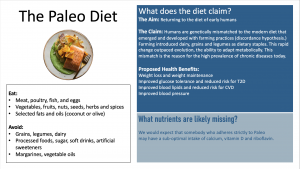
The Scientific Evidence
The Paleolithic Diet has not seen the same success as the diets discussed in the previous section. We can see the discrepancy in the current research available to us. Researchers have been unable to find any data supporting weight loss, blood lipid control, improved insulin resistance and glucose tolerance, or reduced risk of CVD and high blood pressure.
In summary, proposed health benefits are hypothetical and not supported by evidence. The Paleolithic diet should be taken with caution as there are only a few short, small studies that have found benefits to the paleo diet. The Paleo Diet clearly promotes many healthful foods and we know a high intake of fruits and vegetable is very desirable. Eliminating added sugar and processed food is a benefit to this diet, but the complete elimination of certain food groups poses the risk for numerous nutrient deficiencies.
The main question is: Does the elimination of grains, legumes and low-fat dairy have any additional health benefits over a healthy mixed diet?
A couple of studies compare the Paleo diet with other healthy eating patterns such as the Mediterranean diet. There is no evidence that a diet without legumes, whole grains and dairy is superior. In contrast, many studies show clear health benefits for including those food groups in a healthy diet such as with the Mediterranean diet. High fiber content, nutrient density and phytochemical content show preventative benefits for type 2 diabetes and cardiovascular disease. Before eliminating food groups that provide essential nutrients and health benefits, long-term intervention trials need to demonstrate an advantage.
Aside from the unclear science, following the Paleo diet can be expensive. Grass-fed, organic meat, wild game, and fatty fish are not affordable options for many Americans. Legumes, whole grains and dairy tend to be inexpensive and nutritious foods that most Americans can afford.
What is the downside of just trying?
- The Paleo diet might be a short-term option to kickstart a lifestyle change and learn a few healthy eating habits for some. Although, these healthy habits should be expanded to all food groups over time. Each food group provides essential nutrients and the more restrictive the diet, the higher the risk is for long-term inadequate intake.
- Since there are no long-term studies that prove nutrient deficiencies are not of concern, the Paleo Diet cannot be recommended long-term.
- Restrictive diets tend to be followed as long as they are novel. Once the novelty wears off and the diet becomes inconvenient, adherence will rapidly decline. Studies showed that this point is usually reached around six months into the diet. Often the short phase of dieting is followed by a return to the previous, unhealthy eating habits.
Ketogenic Diet
History of The Ketogenic Diet
The most prominent fad diet out there at the moment is the Keto Diet which is an extremely high-fat and extremely low-carbohydrate diet that has drastically increased in popularity over the past years. Interestingly enough, the Ketogenic diet has gone through significant changes to become the popular fad diet it is today.
Before anti-seizure medications were developed, the only known treatment to reduce seizures was fasting. This reaches as far back as Biblical times.
Their first scientific studies were conducted in the 1920’s on epileptic children and adults who were subjected to a starvation diet that consisted of minimal carbohydrate and fat intake. The initial results were a substantial 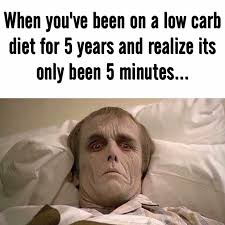 reduction in seizures for both populations. Although they had success with reducing seizures, starvation will lead to severe nutrient deficiencies which can lead to serious health concerns and conditions.
reduction in seizures for both populations. Although they had success with reducing seizures, starvation will lead to severe nutrient deficiencies which can lead to serious health concerns and conditions.
Fasting triggers a survival mechanism for times of food shortages called ketogenesis. Curious physicians thought they might be on to something and set out to modify the initial approach of starvation to reach ketogenesis. They found that ketogenesis can be activated by consuming a very small amount of carbohydrates and a large amount of fat.
The new approach—dubbed the ketogenic diet—was more balanced and could be sustained longer. Generally, popular ketogenic resources suggest an average of 70-80% fat, 5-10% carbohydrate, and 10-20% protein while meeting daily energy requirements. The ultimate goal is to have the patient enter a state of ketosis and maintain the ketosis so the brain adapts to using ketone bodies as an energy source instead of glucose.
If you forgot the biochemistry of ketogenesis, make sure to review:

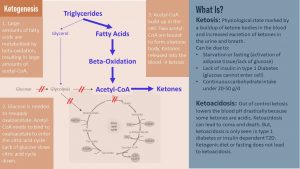
Working your way through this infographic, it becomes clear that ketosis can only be maintained if the carbohydrate intake and protein (glucogenic amino acids) intake is low enough to enable the body to start utilizing fat for its main source of energy.
This also means that when you are on the keto diet, days of increased carbohydrate intake are not allowed as the glucose deprived brain will happily come out of ketosis. For seizure patients, this extreme diet was well worth the hassle and the risk for deficiencies because they experienced better or complete seizure control.
The keto diet is an extreme diet and eliminates many nutrient dense foods while adding a lot of saturated fat. This means that the downsides need to be weighed against the benefit. In the case of seizure disorders, the downsides seemed acceptable (seizure medications were not developed until the 1960s). The exact mechanism for how ketosis aids in reducing incidences of epilepsy is not fully understood. Scientists hypothesize that the changes of brain metabolism in seizure patients alter the glucose metabolism of the brain. There is still a debate going on regarding how much fat someone should consume in order to enter and maintain ketosis safely over a long time. Recommendations range anywhere from 60-90% of energy coming from fat with 75% being the average.
At the end of the day, the ketogenic diet was never seen as an eating pattern, but as medical nutrition therapy for a very specific condition. Even today, the ketogenic diet is still used in children if medication is not effective.
Why is the keto diet such a popular diet today? The ketogenic diet is discussed for:
- Endurance athletes on the search for a diet that acts as a “work-around” for glycogen storage problems, but still provides them with energy
- Patients with diabetes (especially Type 1 Diabetes) who have trouble maintaining their blood glucose long-term
- Extremely fast, short-term fat and weight loss
What exactly is the Keto diet? Most of your friends claiming to be on the Keto diet are more likely on a low-carb diet as the keto diet requires a very strict and consistent intake to remain in ketosis. On the other hand, the Keto diet is not just eating mountains of meat, fatty fish, cheese, and spoonful’s of butter and coconut fat. Have a look:
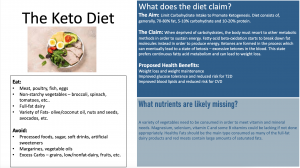
The Scientific Evidence for The Ketogenic Diet
The Ketogenic diet has grown in interest for researchers in recent years. Most of this however, is fairly short-term but many clinical trials have demonstrate promising findings for some applications. A few long-term studies have been conducted but the results are controversial and not enough have been conducted to demonstrate solid findings. Researchers have found evidence supporting: weight loss, blood lipid control, better insulin resistance and glucose tolerance, and reduced risk of developing CVD. There is little evidence suggesting that keto diets reduce high blood pressure. It’s important to note that even though keto is high in fat, healthy blood lipid levels can be maintained IF a large amount of fat intake comes from food sources high in MUFA and PUFA.
In summary, the ketogenic diet has only be introduced recently for other purposes than treating epilepsy. At this point we only understand some of the short-term effects, but have no idea about long-term effects.
The keto diet is an extreme diet for extreme situations and should not be adopted as a log-term eating pattern without professional supervision. Modified versions of the keto diet have been developed to meet different nutrient needs while still being able to maintain ketosis.
Low-Fat Diet
History of Very Low-Fat Diets
Low-fat diets are based on scientific studies dating back to the 1940’s but didn’t start gaining ground in the scientific community until around the 1960’s when rates of chronic diseases such as obesity and heart diseases started to rise. Those early studies showed that high saturated fat intake was increasing LDL cholesterol and high LDL cholesterol was the best indicator for coronary heart disease.
In addition observational studies demonstrated that the traditional Japanese diet with under 15% energy from fat resulted in a healthy population with little heart disease. Physicians started to recommend the low-fat diet to their patients.
Over the next 20 years, a few studies came out demonstrating a slight association between low-fat diets and weight loss as well as reduced risk for heart disease. This was enough to recommend the low-fat diet for everybody.
Here was the conundrum. A Japanese diet is based on vegetables and rice with small portions of fish. This food culture easily translated into a very-low fat diet. The Western European food culture of meat, dairy, eggs, starch, vegetables and fruits did not. Since fat cannot just be cut but needs to be replaced the low-fat food industry took off.
Low-fat yogurt, lunch meat, cheese, cookies and crackers taste terrible. Food scientists went to work and came up with products that were low fat and still relatively tasty (who am I kidding, even those wonders of food chemistry didn’t taste as good as the real thing).
What many didn’t initially realize was that those products upped starches and sugar. As a consequence most people didn’t eat the healthy Japanese style low-fat diet. Per recommendation and cultural food habits Americans ate a processed food, low-fat plus tons of sugar and refined carbohydrate diet.
This was of course not healthy. In addition scientific studies realized that high sugar and refined carbohydrates crank up blood triglycerides which also contributes to CVD.
Today, the recommendations moved away from fat is bad, anything else is good. The recommendation as you well know is to switch out saturated fat with MUFA and PUFA and maintain a moderate fat intake of 20 – 35 % energy from fat to maintain a healthy HDL. Eating a Mediterranean diet with lots of olive oil the fat intake is 40% of energy.
This is the shift nutrition professionals would have liked to see. As years passed and research on this subject continued to develop, the low-fat ideology that consumed America faced the counter movement of low-carb diets.
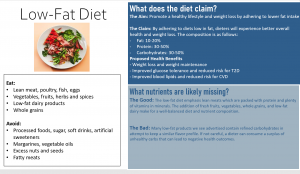
Scientific Evidence for Low-Fat Diets
The research findings for low-fat diets are similar to that of the keto diet. The difference between the two is that the low-fat diet has been researched for far longer than keto has thus more solid evidence is available. These findings support weight loss, blood lipid control, improved insulin resistance and glucose tolerance, and reduced risk of CVD and high blood pressure.
In summary, the low-fat diet or better, a low saturated fat diet, has been studied extensively. The results of most, if not all, comparative studies have shown that moderate-fat intake diets such as DASH, vegetarian or Mediterranean diet are more likely to promote weight loss, control blood lipids, control glucose levels, and improve blood pressure than low-fat diets.
Most research suggest that low-fat diets are harder to adhere to and participants are prone to consuming more refined carbohydrates than protein which is less than ideal.
Low Carb Diet (Atkins)
History of the Atkins Diet
In the late mid 1950’s, the medical field welcomed a newly certified cardiac physician by the name of Dr. Robert Atkins. His specialty in cardiology was inspired by the current treatment for weight loss in cardiac patients – medication to reduce hunger. Dr. Atkins wanted to find a better alternative for weight loss especially with the rising rates of chronic disease in the country. So, in the early 1960’s Dr. Atkins began his search for the best weight loss regimen by engaging with the research and nutrition communities. He found many studies pointing toward carbohydrate restrictions as suitable weight loss methods. Dr. Atkins, along with many of his colleagues attempted to replicate these findings by going on low-carb diets themselves. In the end, him and all of his colleagues experienced some degree of weight loss.
With his findings confirmed, Dr. Atkins set out to share his knowledge with the world and, in 1972, he published his novel Dr. Atkins’ Diet Revolution. His book proclaimed the newly found weight loss miracle and sparked a low-carb revolution in America at the time.
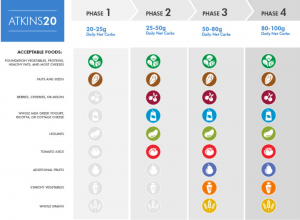
Even though public consumerism adopted it immediately, the Atkins diet was seen as controversial in the scientific community especially with it being founded on minimal clinical studies.
Today the Atkins diet has been through many clinical trials to establish short and long-term effects. Most consider it the “mother of all low-carb dieting” with many of todays popular low-carb diets, like keto and south beach, stemming from Atkins. The most notable aspect of Atkins that sets it apart from others low-carb diets is its phase process. The diet consists of four phases – each phase gradually increasing the daily carb limit and broadening food choice.
- Phase One – Induction : Carbohydrates are extremely limited along with food choice. There are three different programs that the Atkins website offers, each of which have different carbohydrate starting limits (20, 40, and 100 grams). Dieters stay in this phase for the first two weeks.
- Phase Two – Balance : Carbohydrate limit increases by about 10 -15 grams depending on weight loss goals. Allows more food to be incorporated into the diet to practice balance. Dieters will stay in this phase until they are about 10 pounds from their weight loss goal.
- Phase Three – Pre-Maintenance : Carbohydrate limit increases by about 15-25 grams depending on weight loss goals. Allows most foods to be incorporated including whole grains and high glycemic fruits and vegetables. This phase will last until the dieter has reached their goal weight
- Phase Four – Lifetime Maintenance : Carbohydrate limits can increase or stay the same as long as the goal weight is maintained. The dieter is prompted to maintain this way of eating for life and adapt their dieting if excessive weight gain or loss starts to occur.
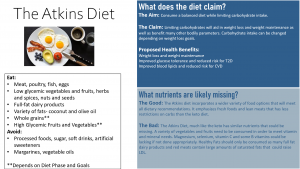
Scientific Evidence for Atkins Diet
The current research on the Atkins diet has shown fairly promising results. These results show that short-term (3-6 month) adherence to the Atkins diet supports weight loss, blood lipid control, improved insulin resistance and glucose tolerance, and reduced risk of CVD and high blood pressure. The long-term effects (around 12 months) of Atkins are not supported by any present research.
In summary, the Atkins diet has demonstrated short-term benefits across many physiological functions. It’s far less restrictive than keto, and the phase plan allows for a gradual increase in carb intake and more food options to make the diet easier to maintain. However the long-term effects of Atkins are controversial with some studies even suggesting worsening health outcomes such as heart arrhythmias, kidney complications, and osteoporosis. Low- carbohydrate diets are hard to adhere to and must followed precisely to avoid foods high in saturated fat, excessive protein, and missing important vitamins and minerals.
Activity Summary
In this activity we examined four different popular diets commonly advertised in today’s consumer market. Despite the limited research, these diets have been widely advertised and adopted. It can become easy to get lost in the promises of weight loss and self-improvements especially when we see it plastered all over the media. The validity of these diets are not found on Facebook or Instagram posts but rather in grounded research and clinical trails.
When we compare the amount of research and success with popular diets like these to the recommended dieting patterns discussed in the previous section, we find more consistent and solid findings for recommended dieting patterns every time.
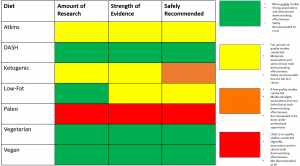
Interested In More Information?
Sources
Keto Diet
https://www-sciencedirect-com.libproxy.unl.edu/science/article/pii/S0024320520314144
https://www.ncbi.nlm.nih.gov/pmc/articles/PMC5782363/
https://www.ncbi.nlm.nih.gov/pmc/articles/PMC3826507/
https://www.ncbi.nlm.nih.gov/books/NBK499830/
Low-Fat Diets
https://pubmed.ncbi.nlm.nih.gov/26250104/
https://www.cambridge.org/core/journals/british-journal-of-nutrition/article/better-dietary-adherence-and-weight-maintenance-achieved-by-a-longterm-moderatefat-diet/37DCB9EA37CA48F8EC8CE85ED76428B3
https://academic.oup.com/ajcn/article/79/2/204/4690082
https://academic.oup.com/jhmas/article/63/2/139/772615
https://health.gov/our-work/food-nutrition/2015-2020-dietary-guidelines/guidelines/appendix-7/
https://www.ncbi.nlm.nih.gov/pmc/articles/PMC5577766/
Atkins Diets
https://www-sciencedirect-com.libproxy.unl.edu/science/article/pii/S0140673604169869
https://www.mayoclinic.org/healthy-lifestyle/weight-loss/in-depth/atkins-diet/art-20048485#:~:text=Results-,Weight%20loss,may%20initially%20lose%20water%20weight.
https://www.ncbi.nlm.nih.gov/pmc/articles/PMC6074441/


Feedback/Errata